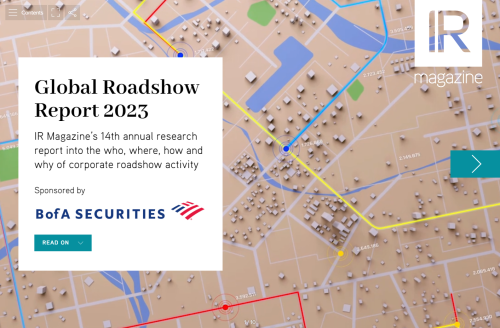Everything an IRO needs to know for planning a roadshow to Canada’s financial center
While other money centers bucked and buckled, Toronto rode out the financial crisis with an air of serenity. Having not messed excessively with subprime mortgages, leveraged balance sheets or securitization, the city’s banks avoided the worst of the storm that gutted other financial communities around the world.
The conservatism that kept Canada safe is evident among Toronto’s buy-side community. ‘When you come here, you’re meeting with long-term-oriented investors with an average investment horizon of three to five years, who place a high value on meeting with management,’ explains Meghan MacNicol, a corporate marketing associate at RBC Capital Markets.
That fact belies the amount of assets managed in Toronto. In a city of big institutions, the daddy is the Canada Pension Plan Investment Board, which controls assets worth roughly C$140 bn ($147 bn).
Five biggest mutual funds (C$ bn)1. RBC Asset Management – 88.42. TD Asset Management – 59.9 3. CIBC Asset Management – 50.1 4. Fidelity Investments Canada – 49.9 5. Mackenzie Financial Corporation – 42.2 Source: Investment Funds Institute of Canada |
The Ontario Teachers’ Pension Plan is no lightweight, either, managing more than C$100 bn of its own. In total, there are 10 or 15 large institutions based in Toronto for issuers to choose from, most of which are based in a tight huddle in the downtown area.
In a further fillip to visiting companies, it’s worth noting that assets managed in Toronto and invested globally have increased since the decision in 2005 to lift the 30 percent limit on foreign content in registered pension plans, a move institutional investors had lobbied in favor of for years.
Early risers
On a typical day in Toronto, companies can expect a packed day of six or seven one-on-one meetings, running from as early as 7.30 am until 4.00 pm, as well as a group meeting over lunch thrown into the mix. Large-cap companies often stay on and do it all again for a second day.
Apparently, many US management teams turn up armed with power bars to snack on, because they don’t expect to be fed until lunch. Luckily, early morning meetings are usually held over breakfast, providing much needed sustenance for the long day ahead.
The city’s buy side covers a mixture of different investment styles: there are fundamental, value, growth and GARP investors, although not as much hedge fund activity as you’ll find in places like New York or London. One broker puts this down to the lower liquidity on Toronto Stock Exchange (TSX), which makes it hard to borrow stock and thus restricts shorting strategies.
Along with the dominant role of long-term investment strategies and the lack of hedge funds, there is a third characteristic of Toronto’s buy side that commentators like to highlight: the significant and highly engaged retail investment community. According to stats from TMX Equicom, the IR firm owned by Canada’s main exchange operator, nearly half of all Canadians own stock.
Making your pitch
As in any other roadshow situation, the decision of who to target will be determined by your size and sector. It may be hard to get the attention of the big pension funds if you are a small or mid-sized company, simply because of the size of the assets these funds have to invest.
For smaller firms, it is easier to get meetings if you come from sectors less well represented in the Canadian market, such as technology or healthcare, because investors will be looking to other markets for exposure in these areas. Growth companies in the energy sector may struggle, on the other hand, as these are well represented on TSX.
When it comes to making your presentations, the format tends to be the same as in other financial centers in North America and Europe, says John Vincic, vice president of IR and corporate communications at Toronto-based HudBay Minerals, and a Toronto city resident since 1995. ‘If they are familiar with the story, they might go straight to Q&A,’ he explains.
Places to eatCanoe54th Floor, Toronto-Dominion Bank Tower 66 Wellington Street West +1 416 364 0054 Earls (modestly priced option) 150 King Street West, Suite 100 +1 416 916 0227 Hy’s Steakhouse 101-120 Adelaide Street West +1 416 364 6600 Jump 18 Wellington Street West +1 416 363 3400 |
‘If they are new to the story, they might want you to walk them through your presentation flip book, and they’ll interject with questions as they see fit.’
Most buy-side accounts and brokers are located within a short distance of each other in the financial core, so if you fancy a bit of exercise and the pitch book isn’t too heavy, it’s quite possible to walk from one meeting to another.
Given the city’s extreme weather conditions, however, you may not always be able to walk outside – although that doesn’t mean a car is essential. Many hotels, office blocks, restaurants and shops located downtown are connected by a system of underground walkways called the Path. Totaling 28 kilometers in length, the Path offers a weatherproof way for people to travel from one part of the city to another.
The subterranean walkways are there to protect residents and visitors from Toronto’s harsh winters and stifling summers. In the winter, daytime temperatures stay well below zero and snow is frequent; in summer, the heat of the day can peak at a scorchingly hot 40°C.
‘When you’ve been doing this for a long time, you know every nook and cranny and can find a way to get to meetings without having to surface,’ says Craig Armitage, a senior vice president at TMX Equicom and also a Toronto resident.
Overcoming the elements
The snow, especially, can complicate traveling. One change that has improved logistics in recent years has been the reopening of Billy Bishop Toronto City Airport (more commonly known as Toronto’s Island Airport) to commercial planes. The airport is handily located a short 15-minute drive from the city center.
It’s a good idea to consider where to stay in conjunction with your roadshow schedule. Unlike most of the city’s big accounts, the Ontario Teachers’ Pension Plan is located uptown, in an area called North York. If that’s your first meeting, then good choices for places to hole up include the Hazelton Hotel and the Four Seasons.
Places to sleepFairmont Royal York100 Front Street West +1 416 368 2511 Four Seasons 21 Avenue Road +1 416 964 0411 Hazelton Hotel 118 Yorkville Avenue +1 416 963 6300 Le Méridien King Edward 37 King Street East +1 416 863 9700 |
For those starting downtown, popular options with local brokers include the Fairmont Royal York (once the tallest building in the British empire, way back in the 1920s), Le Méridien King Edward – known locally as the King Eddie – and the Ritz Carlton.
Come the end of the day, that hearty breakfast will feel like a long time ago, so why not head to one of the restaurants favored by the city’s financial community, such as Canoe, ensconced on the 54th floor of the Toronto-Dominion Bank Tower, with a sweeping view over Lake Ontario.
Jump also comes highly recommended. Located on Wellington Street in the financial district, it serves good food, fast, according to Armitage, so it’s a good place to pop in for a bite to eat if you have only an hour or so before that evening flight home.










